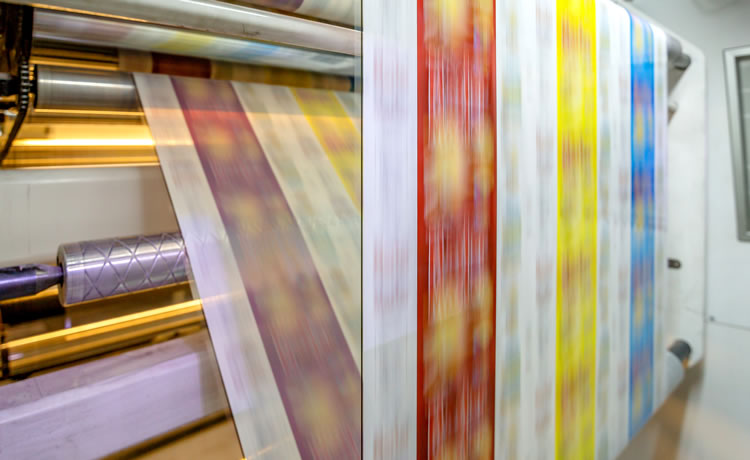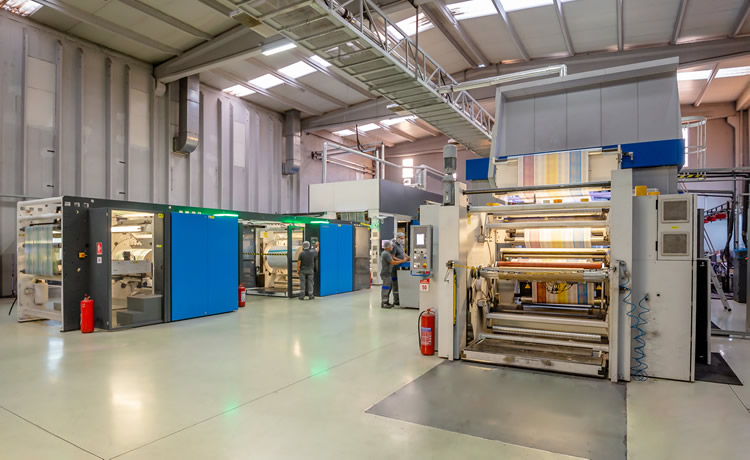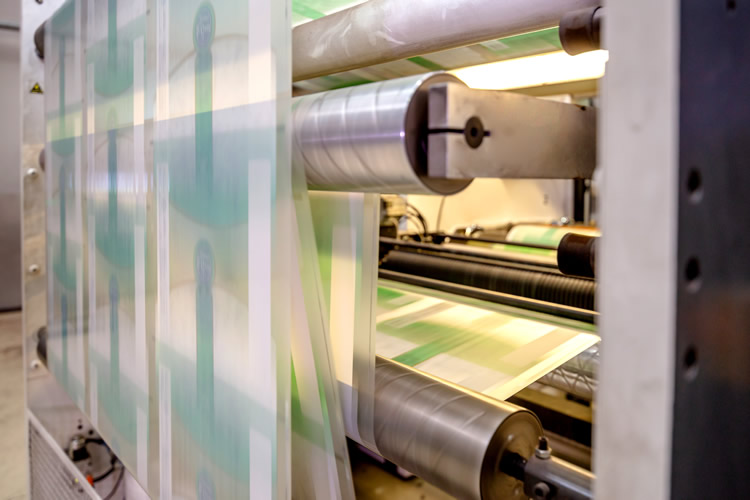
Flexo printing is a printing technique used today in the printing processes of packaging materials, labels and other similar products. For this reason, it is frequently preferred in the packaging industry. The main purpose of this printing method is to print on large areas and is known for printing quickly. flexo printingIt is suitable for printing on flexible and flat surface materials and is generally preferred for printing on materials such as cardboard, plastic films, metal foils and paper. One of the most important features of the flexo printing applied by Üçsa Ambalaj is that it can print colorful and eye-catching designs in high quality.
What is Flexo Printing Technique?
Flexo printing techniqueIn flexo printing, the material to be printed starts with being at a certain height from the body of the mold. This is achieved by covering the raised printing surface with ink with the help of a roller and then contacting this roller with the printing material. This technique is based on applying ink in thin layers and printing it on the surface. The design to be printed is engraved on a flexo printing plate and provided with laser technology. In this way, surfaces with a raised printing surface absorb the ink and transfer it to the surface to be printed. Üçsa Ambalaj flexo printing techniques, which we enriched with lacquer applications, have a 100% printing and color system.
Materials Used in Flexo Printing
Materials used in flexo printing are:
- Flexo Plates: It contains a raised surface of the print design. Since it has a flexible structure, it can be bent easily. These plates are either etched into the surface of the design or created by laser.
- Printing Material: It is the material on which the print will be made. They are mostly materials such as plastic film, paper, cardboard or metal foil.
- Printing Cylinder: It is the cylinder on which the design is transferred. It is in contact with the printing material.
- Ink Roller: It is the cylinder that carries the ink. It covers the raised surfaces of the plate.
- Anilox Roller: It is the roller that transfers the ink to the printing surface. It ensures that it is taken from the plate properly.
As Üçsa Ambalaj, we implement flexo printing techniqueIt can operate at high speeds and is effective on large surface areas. For this reason, flexo printing is common in the packaging industry. It is a preferred printing technique thanks to its high color pigments and fast production processes and is especially suitable for large numbers of prints.
What are the advantages of Flexo Printing Technique?
Flexo printing technique is a type of printing that offers many advantages, especially in the packaging industry and commercial label printing. At work Advantages of flexo printing technique:
- Packaging Applications: Flexo printing is the most ideal type of printing for printing on packages. For this reason, it is preferred in printing products such as food packaging.
- Speed and Efficiency: This type of printing is a technique that can work at high speeds. It enables rapid printing of large numbers of products, thereby increasing production efficiency.
- Low Costs: Preparation of printing plates used in flexo printing generally costs low prices. This is economical for materials to be printed in large quantities.
- Wide Range of Materials: The application of flexo printing is suitable for many types of materials. It can do flexo printing on different surfaces such as plastic film, metal foil, paper and cardboard.
- Color Accuracy and Intensity: The most well-known feature of flexo printing is high color density and fine details are not lost. In this way, flexo printing is important in printing multi-colored and eye-catching designs.
- Eco-Friendly: In line with environmentally friendly and sustainable packaging demands, flexo printing technique can be used appropriately with environmentally friendly inks and recyclable materials.
Flexo printing, which Üçsa Ambalaj also uses, has become an effective printing technique with a wide usage area in the packaging sectors and label printing with these advantages.

Flexo Printing Process and Stages
Flexo printing is a method used especially in packaging and commercial printing. At work flexo printing processThe basic stages of:
- Design Preparation: First, the design to be printed is prepared. These designs are made using computer-aided design (CAD) software. The colors, details and placement of the design are determined at this stage.
- Preparation of Flexo Plates: Flesco plates are prepared so that the design can be transferred to the printing surface. These plates contain the raised areas of the design. These plates, usually made of flexible polymer or rubber, can be bent easily. Designs are transferred to the plate by laser or engraving methods.
- Ink: Inks to be used in flexo printing. These inks are then transferred to the printing surface and printing is done. At this stage, ink colors and types are selected according to the person or institution receiving the service.
- Adjusting the Printing Machine: The flexo printing machine is prepared for the correct placement of plates and cylinders. Inks are placed on the anilox cylinder. Afterwards, the printing material is put into the machine.
- Printing Process: Thanks to the anilox roller, the ink is transferred to the flexo plate. Ink passes into the raised areas of the plate, while flat areas do not absorb ink. In this way, the protruding parts of the design are covered with ink.
- Transferring to Printing Material: The flexo plate sends the area covered with ink to the printing material. The printing material is also brought into contact with the flexo plate thanks to the printing cylinder. Thus, the design is transferred onto the printing material.
- Drying Process: After the printing process is completed, the ink on the design is left to dry. At this stage, the design is expected to be fixed. Afterwards, the printing material is often cut into rolls and folded to make it ready for other final processes.
Flexo printing stagesIt brings a fast result, mostly in cases requiring mass production. Üçsa Ambalaj achieves successful results with correct adjustments, quality plates and appropriate ink selections in flexo printing processes.
Industrial Uses of Flexo Printing
Flexo printing is a printing method with a wide range of industrial uses. It is frequently preferred especially in the packaging and commercial printing sectors. At work Industrial uses of flexo printing:
- Packaging Industry: Flexo printing is an ideal technique for printing on packaging materials. Different types of packaging such as food packaging, plastic bags, pouches, pharmaceutical packaging, cardboard boxes can be printed with flexo printing.
- Flexible Packaging Materials: Flexible packaging materials are used in the packaging of products such as pasta, coffee, tea, snacks and nuts. It is suitable for flexo printing on such flexible materials.
- Label Printing: Product labels, especially used in the food, beverage, personal care products and pharmaceutical industries, are important for brand awareness. Therefore, flexo printing is preferred for fast and high-quality printing of labels.
- Plastic Film and Foil Printing: Plastic films and foils are used for packaging materials and industrial products. Flexo printing is also an effective method for printing colorful designs on these materials.
- Magazine and Newspaper Printing: Flexo printing is used in printing large-scale printing materials such as magazines and newspapers. The fast production ability and high quality of flexo printing make it valuable in this sector.
- Hygiene Products Packaging: Flexo printing can be preferred in the packaging of products such as baby diapers and sanitary pads.
- Paper Products Printing: Flexo printing can be used to print paper products such as business cards, catalogs and brochures, especially cardboard boxes.
- Plastic Cover Labels: Labels placed on beverage bottles, jars or plastic caps can be printed with flexo printing.
Widely used across industries flexo printing methodIt is highly preferred thanks to its wide range of applications. With the flexo printing service offered by Üçsa Ambalaj, high speed, low cost and flexibility can be preferred in many different sectors.

Frequently Asked Questions About Flexo Printing
In which industries is flexo printing commonly used?
The usage area of flexo printing is quite wide. It is generally preferred in sectors such as flexible packaging, labels, newspapers, magazines and hygiene products. Üçsa Ambalaj, on the other hand, makes flexo printing applications on food packaging, chemical and hygienic product packaging and pet food packaging.
What materials can Flexo Printing be applied to?
Flexo printing can be applied to many different materials. In particular, it is possible to apply flexo printing to many different materials such as plastic, paper, cardboard, metal and flexible packaging materials. As Üçsa Ambalaj, we make high quality prints on any material using the flexo printing technique.
What are the advantages of flexo printing compared to other printing methods?
The advantages of flexo printing over other printing methods include fast production, high printing speed, low cost and wide range of materials. While performing flexo printing applications, Üçsa Ambalaj makes your brand stand out in your market by printing very fast and high resolution packaging.

